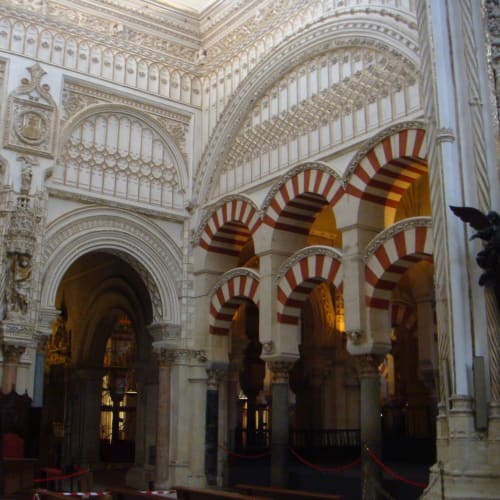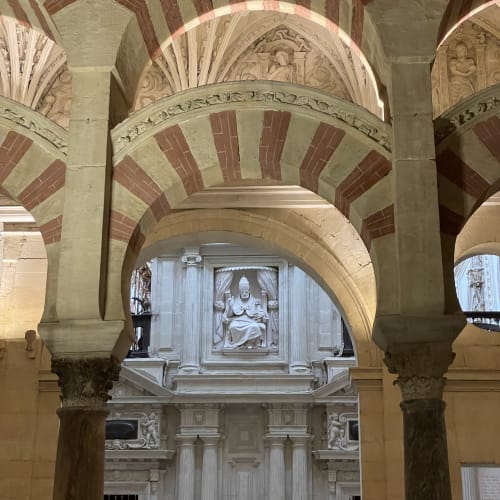Echoes of Faded Glory
January 2010




Modern Spain is complex, an amalgam of medieval kingdoms. In fact the autonomous region of Navarre still refers to itself as the "Kingdom of Navarra." I find it fascinating when I stroll the streets of many historic towns of Spain to recall the "place in the sun" they once enjoyed. It is a good way to put things into perspective and to realize that the concerns we may think are so crucial today are actually so ephemeral.
The city of Córdoba comes to mind. It is a pleasant regional city in Andalucía, which I visit quite often, yet it was quite different 1,100 years ago. At that time Córdoba represented the zenith of Islamic culture, rivaling Babylon, Rome and Baghdad in magnificence and importance. It was viewed by many as the greatest city on earth. At a time when few Christian monarchs could write their names, Córdoba had a library of half a million books and possessed far more wealth than all of European Christendom. Scholars and artists abounded.

Córdoba had a thoroughfare stretching along the bank of the Guadalquivir River that was used for elaborate public processions. It had an astonishing array of shops with products from China, India, Central Asia and the Near East. The royal market for luxury goods, al-Qayseriyya, was fabled. Taverns, caravanserais, baths and inns served the merchants and other travelers who flocked to this, the most important cultural center of the western Mediterranean.
Córdoba had nine hundred public baths and countless private baths at a time when baths were a rarity in the rest of Europe. Six hundred years later there still was no effective sewage system in the largest cities of Europe. Many posit that it was the influence of this flourishing Moorish culture of Córdoba that gave the Spanish people that unique sense of personal dignity and courtesy that they still possess. Perhaps it is the best gift we received from the glorious Moorish culture.
Today the splendor of that magnificent culture has faded. All that remains of Córdoba’s glorious days is the Mesquita: the Mosque, now called La Catedral. Should you choose to enter one of the Mosque’s nineteen doors, you find yourself in a forest of more than 860 slender columns of marble, porphyry and jasper that support a timber roof, arches richly decorated with scarlet and gold. Hundreds of years ago, 280 huge silver or brass chandeliers burned perfumed oil to illuminate the interior on special occasions. The largest was 38 feet in circumference with 1,454 lamps. Fitted into its reflector were 36,000 plates of silver, riveted with gold and decorated with jewels.
The Mosque of Córdoba was as sacred to medieval Islam as the sublime Hagia Sofia in Constantinople was to Christendom. Is it not a monument to the folly of man that the two greatest religious structures in the West have been reduced to museums by bitter religious rivals? Still, when I visit either of them, I experience a little of the sense of the divine which inspired their builders.
There are many other cities of faded glory in Spain that are intriguing to visit even though they have a less monumental aspect. One is Tordesillas, a few miles west of Valladolid, where a treaty was drawn up in 1494 which affected all of the New World. It was clear after Columbus’ discoveries that conflict would soon arise over land claims by Spanish and Portuguese explorers.
On May 4, 1493, Pope Alexander VI took action to clear up any confusion that may have arisen. He issued a decree which established an imaginary line running north and south through the mid-Atlantic, 100 leagues (480 km) from the Cape Verde islands. Spain would have possession of any unclaimed territories to the west of the line and Portugal would have possession of any unclaimed territory to the east of the line.
After further exploration, the Portuguese grew dissatisfied with the agreement when they realized how much more land Spain had been given. In June of 1494, the line was renegotiated and the agreement was officially ratified during a meeting in Tordesillas. The Treaty of Tordesillas reestablished the line 370 leagues (1,770 km) west of the Cape Verde Islands. There were many unanticipated, if not tragic, consequences.

But the Treaty may not be the most fascinating period in Tordesillas’s past, even if it might be the most astonishing from our modern perspective. Originally a bulwark of the defensive line of the Reconquista, Tordesillas received its charter in 1262 from Alfonso X, the Wise. Eighty years later, his grandson Alfonso XI built a substantial castle with adjoining convent. Alfonso’s son, Pedro the Cruel, embellished it in the style of the Alcazar in Sevilla. It was there that he abandoned his bride Blanche de Bourbon on their wedding night, locking her up in the palace and Convent of Santa Clara in order to run off with his lover, María de Pedilla. Ultimately Pedro gave the convent and palace to his two illegitimate daughters by María.
Ah, but if that were not enough intrigue for one little town, Princess Juana, the troubled daughter of Ferdinand and Isabella became Queen of Castile in 1504, only to be overwhelmed with grief when her beloved husband Philip the Handsome died in his prime only two years later. Although she remained a monarch, in name only, she was confined in the convent from 1509 to her death in 1555, a melancholy period of 46 years.
Tordesillas now? It is a transit hub for trucks going from Madrid to Salamanca and beyond, with a population of 8,643 souls. Agriculture is its basic source of income. Although it is situated on the Duero, the river silted up long ago. When Ruth and I decided to visit the Convent of Santa Clara, we parked our car in a broad area, almost like a playground. While young boys were playing soccer energetically nearby, we slipped into the convent. In the chapel, remnants of the past still echoed, not only in the elaborate ribbing of the ceiling, but also in the silent harmonium that Juana enjoyed playing as she whiled away her hours and years.
Then there are the cities of Cartagena, Zamora, Oviedo, Soria, Ciudad Rodrigo, El Burgo de Osma, Sanlúcar de Barrameda – my list is long. As I said at the beginning, a way to gain a healthy perspective is to know what has gone before. Our country is so young that it is harder to do that. But when you dig into an ancient culture such as Spain’s, you learn that much of human endeavor fades. What is lasting are the bonds of love we share with family and friends.
My best wishes for a productive and happy new year!
Don

